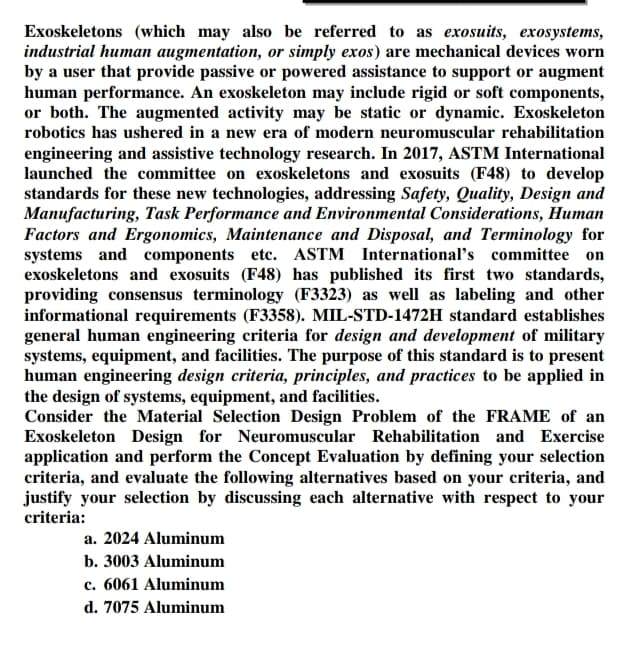Consider the Material Selection Design Problem of the FRAME of an Exoskeleton Design for Neuromuscular Rehabilitation and Exercise application and perform the Concept Evaluation by defining your selection criteria, and evaluate the following alternatives based on your criteria, and justify your selection by discussing each alternative with respect to your criteria: a. 2024 Aluminum b. 3003 Aluminum c. 6061 Aluminum d. 7075 Aluminum
Consider the Material Selection Design Problem of the FRAME of an Exoskeleton Design for Neuromuscular Rehabilitation and Exercise application and perform the Concept Evaluation by defining your selection criteria, and evaluate the following alternatives based on your criteria, and justify your selection by discussing each alternative with respect to your criteria: a. 2024 Aluminum b. 3003 Aluminum c. 6061 Aluminum d. 7075 Aluminum
Elements Of Electromagnetics
7th Edition
ISBN:9780190698614
Author:Sadiku, Matthew N. O.
Publisher:Sadiku, Matthew N. O.
ChapterMA: Math Assessment
Section: Chapter Questions
Problem 1.1MA
Related questions
Question
Department of Mechanical Engineering
PRINCIPLES OF COMPUTER AIDED ENGINEERING – MENG303
Please solve the problem by keupordDepartment of Mechanical Engineering
PRINCIPLES OF COMPUTER AIDED ENGINEERING – MENG303
Please solve the problem by keupord

Transcribed Image Text:Exoskeletons (which may also be referred to as exosuits, exosystems,
industrial human augmentation, or simply exos) are mechanical devices worn
by a user that provide passive or powered assistance to support or augment
human performance. An exoskeleton may include rigid or soft components,
or both. The augmented activity may be static or dynamic. Exoskeleton
robotics has ushered in a new era of modern neuromuscular rehabilitation
engineering and assistive technology research. In 2017, ASTM International
launched the committee on exoskeletons and exosuits (F48) to develop
standards for these new technologies, addressing Safety, Quality, Design and
Manufacturing, Task Performance and Environmental Considerations, Human
Factors and Ergonomics, Maintenance and Disposal, and Terminology for
systems and components etc. ASTM International's committee on
exoskeletons and exosuits (F48) has published its first two standards,
providing consensus terminology (F3323) as well as labeling and other
informational requirements (F3358). MIL-STD-1472H standard establishes
general human engineering criteria for design and development of military
systems, equipment, and facilities. The purpose of this standard is to present
human engineering design criteria, principles, and practices to be applied in
the design of systems, equipment, and facilities.
Consider the Material Selection Design Problem of the FRAME of an
Exoskeleton Design for Neuromuscular Rehabilitation and Exercise
application and perform the Concept Evaluation by defining your selection
criteria, and evaluate the following alternatives based on your criteria, and
justify your selection by discussing each alternative with respect to your
criteria:
a. 2024 Aluminum
b. 3003 Aluminum
c. 6061 Aluminum
d. 7075 Aluminum
Expert Solution
This question has been solved!
Explore an expertly crafted, step-by-step solution for a thorough understanding of key concepts.
Step by step
Solved in 4 steps

Knowledge Booster
Learn more about
Need a deep-dive on the concept behind this application? Look no further. Learn more about this topic, mechanical-engineering and related others by exploring similar questions and additional content below.Recommended textbooks for you

Elements Of Electromagnetics
Mechanical Engineering
ISBN:
9780190698614
Author:
Sadiku, Matthew N. O.
Publisher:
Oxford University Press

Mechanics of Materials (10th Edition)
Mechanical Engineering
ISBN:
9780134319650
Author:
Russell C. Hibbeler
Publisher:
PEARSON

Thermodynamics: An Engineering Approach
Mechanical Engineering
ISBN:
9781259822674
Author:
Yunus A. Cengel Dr., Michael A. Boles
Publisher:
McGraw-Hill Education

Elements Of Electromagnetics
Mechanical Engineering
ISBN:
9780190698614
Author:
Sadiku, Matthew N. O.
Publisher:
Oxford University Press

Mechanics of Materials (10th Edition)
Mechanical Engineering
ISBN:
9780134319650
Author:
Russell C. Hibbeler
Publisher:
PEARSON

Thermodynamics: An Engineering Approach
Mechanical Engineering
ISBN:
9781259822674
Author:
Yunus A. Cengel Dr., Michael A. Boles
Publisher:
McGraw-Hill Education

Control Systems Engineering
Mechanical Engineering
ISBN:
9781118170519
Author:
Norman S. Nise
Publisher:
WILEY

Mechanics of Materials (MindTap Course List)
Mechanical Engineering
ISBN:
9781337093347
Author:
Barry J. Goodno, James M. Gere
Publisher:
Cengage Learning

Engineering Mechanics: Statics
Mechanical Engineering
ISBN:
9781118807330
Author:
James L. Meriam, L. G. Kraige, J. N. Bolton
Publisher:
WILEY